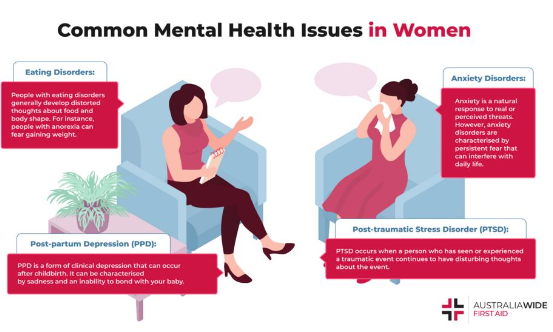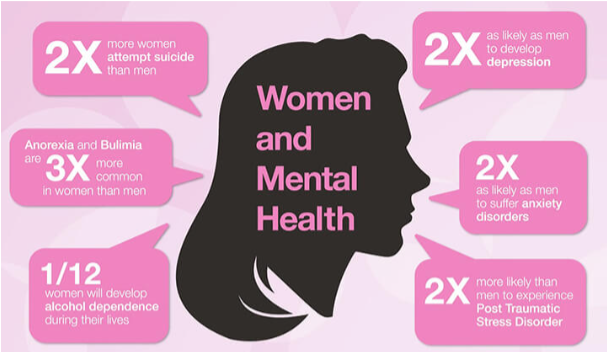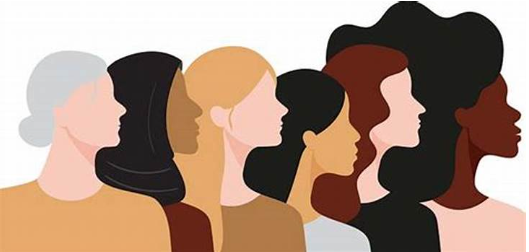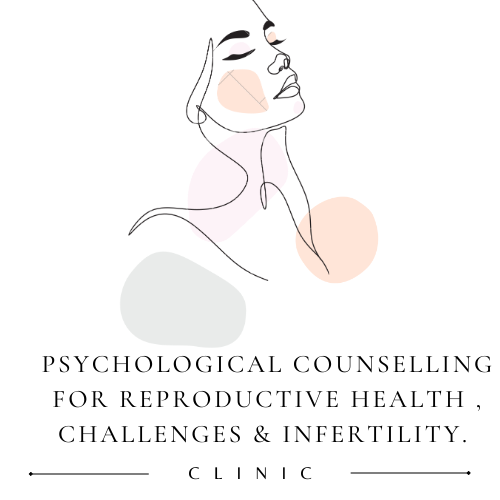Mental health issues in Young Women

Mental health issues in Young Women
Young women, across the globe are known to be more at risk for mental disorders than their male counterparts.
Women's mental health is multifactorial which is determined by both biological and social factors. The greater vulnerability of women can be owing to physiological changes as well as social factors such as poverty, sexual abuse, stress, intimate partner violence, and so on.
We at PCRH Udaipur believe that “Women’s mental health needs to be considered in the context of the interaction of physical, reproductive, and biological factors with social, political, and economic issues at stake”.

Let’s look at the statistics and causes behind this elevated risk in women in this blog.
How Does mental health issues differ between genders?
When it comes to mental illness, women are more likely to be diagnosed with anxiety disorders or depressive disorders, while men tend more toward substance abuse disorders, antisocial disorders and risk-taking behaviours.
Mental disorders are at a rise in young women. 1 in 5 women (19%) experience a Common Mental Disorder (such as trauma or anxiety or depression), compared with 1 in 8 (12%) men.
Do women and men cope differently from stress ?
Yes. Newer research has found that women with anxiety disorders are more likely to internalize emotions, which typically results in overthinking, withdrawal, loneliness, suppression and isolation. Men, on the other hand, are more likely to externalize emotions, which leads to aggressive, impulsive, defiance, avoidance, coercive and noncompliant behaviour. These differences in their liabilities to internalize and to externalize accounted for gender differences in prevalence rates of many mental disorders. At times, these differences also cause interpersonal problems among couples. Gender-focused prevention and treatment efforts can help couples resolve any conflict that arises due to these extreme coping patterns.
What are the common mental health disorders that are commonly found in young women?

1.One of the most common mental health disorders someone might struggle
are Mood Disorder (e.g. Bipolar Major Depressive Disorders).
Twice as many women experience depression at some point in their lives when compared to men. Gender, genetic, social, and economic differences all play a role in the development of depression in women.
2. Anxiety disorders such as panic disorder, phobias, generalized anxiety
disorders, unspecified anxiety disorders are another very common mental
health issues-
issues—one that women are twice as likely to experience as men.
3. Trauma related disorders are also common in women.
The overwhelming
majority of individuals who are exposed to violent conflicts, civil wars, abuse,
domestic issues, displacement from home, and natural disasters are women and
children. About 20% of all women will experience rape or attempted rape at some
point in their lifetime. This may increase the risk of developing a mental health issue.
Women are exposed to higher levels of sexual violence and have higher rates of
post-traumatic stress disorder (PTSD) associated with sexual violence.
4. PTSD is a very common mental health disorder in survivors of domestic
abuse, family discord, interpersonal violence, narcissistic abuse survivors,
marital discord and in people facing physical torture, emotional and sexual
abuse.
When people think of PTSD, they often think of people exposed to combat violence. While this is one factor, women are twice as likely to experience PTSD as men. PTSD in women can cause repeated traumatic experiences. Women as well as their children, are also more likely to develop serious symptoms as a result of PTSD.
5. Eating disorders and Body image concerns
are more common in young women than men.
What are the statistics around ‘Mental ill health among young women and adolescent girls’?

Three quarters (75%) of mental health issues are established before the age of 24 in women. Young women have emerged as the highest-risk group for mental ill health due to physiological neurobiological, psychological and social factors. Data reveals the :-
- A quarter of young women (25.7%) have self-harmed or injured themselves– more than twice the rate for young men.
- 26% of young women experience a Common Mental Disorder, such as trauma or abuse or anxiety or depression – almost three times more than young men.
- 1 in 7 young women (16-24) have Post traumatic stress disorder -PTSD (compared with 3.6% of young men).
- 72% of those in suicide counselling are girls
- Suicide is the third most common reason for girls to contact Childline, and the fifth most common for boys, across the globe.
What are the causes behind women facing more psychological challenges than men?
A.Biological factors can contribute to mental health issues in women, including:
- Hormone fluctuations: Hormone levels, especially estrogen, can impact brain chemistry and contribute to anxiety and depression. For example, women experience significant depression and anxiety during times of lower estrogen levels, such as pre-menstrually or around menopause. During pregnancy too, some women may face more than ordinary amount of emotional lability and tensions. These warrant a psychosocial evaluation and management.
- Reproductive life events: Pregnancy, the postpartum period, and menopause can all be associated with mental health issues.
- Reproductive challenges : Women facing reproductive health problems such as endometriosis, uterine fibroids, gynecologic cancer, HIV, interstitial cystitis, infertility, polycystic ovary syndrome, sexually transmitted infections, and sexual and intimate partner violence face greater anxiety and mood disorders.
- Brain defects or injury: Brain defects or injury can be linked to certain mental illnesses in women.
B.Other socio-cultural and environmental factors that can contribute to mental health issues in women include:
- Substance abuse
- Poor nutrition
- Exposure to toxins
- Social stress, such as poverty, low quality housing and dangerous neighbourhoods
- Violence
- Parenting and child care problems
- Caregiving burden
- Poverty
- Abuse

What is the link between ‘Mental health and abuse’ in women who suffer violence?

There is clear evidence indicating that women’s mental health is linked to their experiences of violence and abuse. More often than not, the abuser is their own friend/family member/spouse. For example:
- 53% of women who have mental health problems have experienced interpersonal abuse.
- More than three quarters of women (78%) of women who have faced extensive physical and sexual violence – in both childhood and adulthood – have experienced life threatening trauma, and 16% have Post-Traumatic Stress Disorder (PTSD).
- Over a third (36%) of women who have faced extensive physical and sexual violence in both childhood and adulthood have attempted suicide, and a fifth (22%) have self-harmed.
Summary

Examining the clinical profile of mental disorders in women brings to light the fact that men and women are affected disproportionately by mental illness. Mental health during pregnancy and postpartum deserves special attention as untreated maternal depression results in serious ill effects in both the mother and the child. Reproductive health problems like infertility, disorders, female sterilization, and reproductive tract complaints also have been related to poor mental health in women. It is important to view mental health programs in a gender-based approach and internet based therapies to circumvent the unique challenges posed by women's mental health today.
We at PCRH Udaipur, have a unique team of specialist doctors to handle these multifactorial challenges in women , their children and their families.


